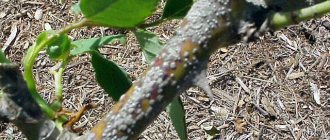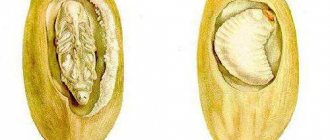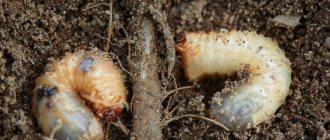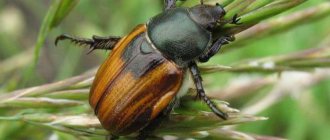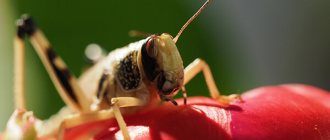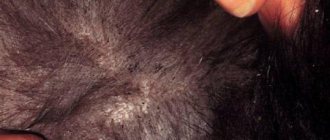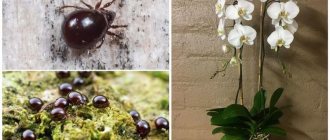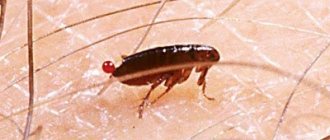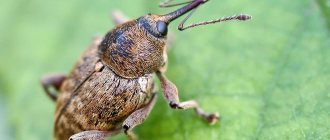All scale insects and false scale insects cause enormous damage to plants. The signs accompanying them are characteristic of all types of scale insects. At the site where the scale insect is sucked, yellow spots appear on the leaves, which grow in size as the juice is sucked out, then the leaf turns completely yellow, curls and falls off. The plant stops growing, the branches become bare, then the entire bush begins to dry out and the plant dies. In addition to leaves, the scale insect damages the fruits of tangerines, lemons and oranges.
Brown scale insect (Chrysomphalus dictyospermi). © fturmo
False shield: photo
False shield.
Varieties
Soft
The adult has an oval brown body, expanding laterally, with a faint dotted line on the back.
The false scale insect can reach 4 mm in length and 1.5 mm in width. The female is capable of producing about a thousand new pseudoscale insects.
Acacia
An adult can grow up to 6 mm in length, with a yellow-brown body with a darker net-like pattern. The body shape is round or oval, the shield is a rich chestnut-red color.
The larva is ellipsoid, brick-colored, grows no more than 2 mm in length. It has antennae and clearly formed legs.
Olive
An adult female has a rounded, very convex body of a dark brown, almost black color, with H-shaped ridge-shaped protuberances on the back.
Hemispherical
The body is spherical, convex, dark chestnut, on the back there is a faint pattern in the form of the letter H. It reaches 4 mm in length, 2 mm in width, and is distinguished by well-formed legs. The larvae are yellow in color and have two tail threads at the end of the body.
Small spruce
Both larvae and adult insects are very difficult to see, because they are perfectly disguised as spruce buds. Painted reddish-brown.
Description of the pest
Name: False scale insects or Coccids Lat.:
CoccidaeClass: Insects - Insecta Order: Hemiptera - Hemiptera
| Habitats: | garden, vegetable garden, greenhouses, rooms |
| Dangerous for: | citrus fruits, ferns, conifers |
| Means of destruction: | mechanical cleaning, traditional methods |
The false scale insect has the appearance of a cake-like oval formation. Initially, these formations have a milky color, then they change to dark brown. The parasite larvae live under such shields until they hatch.
These formations are often not taken seriously, because often people do not pay attention to the first appearances. They look more like growths that can be confused with a manifestation of a disease rather than a pest.
general information
The damage (and its external manifestations) caused by scale insects is very similar, regardless of the type of pest. The scale insect sticks to the leaf, and a yellow spot begins to appear in this place, which begins to gradually increase - the scale insect drinks the juice of the plant. Over time, the leaf turns yellow completely, curls and falls off. The growth of the plant slows down, the leaves fall off, after which the plant begins to dry out and die. Scale insects affect not only the leaves, but also the fruits of citrus plants.
A common characteristic characteristic of scale insects is the presence of protective shields. False scale insects are distinguished by the absence of a shield, but they cause the same damage. Scale insects feed by sucking juice from plant leaves, so they are classified as sucking pests. The main danger is that the larvae spread throughout the plant literally a few hours after they emerge from the eggs, and immediately begin to eat.
Representatives of different species differ only in the color of the shield and the size of the individual itself. The scutum of an adult female is dark or red-brown in color, has the shape of a circle and reaches two millimeters in diameter. Males are smaller, and the scutellum is slightly elongated.
Difference from scale insects
It’s not for nothing that the false scale insect got its name, because it is so easy to confuse with the scale insect. However, there are some distinctive nuances.
- The false shield does not separate from its shield; it can only be removed completely. It looks like a convex growth.
- The scale is separated from the shield when you try to “remove” it, because it serves as a barrier. It is flatter and thinner.
Scale insect and false scale insect.
"Fufanon"
This is the most popular drug used to treat cultivated and ornamental plants. Even in the garden he is able to remain active for two weeks. And if we talk about greenhouses and house plants, then the drug will retain its original concentration for up to a month. This is a huge plus, since you will not have to repeat the treatment after the larvae hatch. There is enough time to destroy all generations. With the help of this drug, the fight against scale insects on indoor plants becomes quite simple.
Its active substance malathion is highly toxic. This is a contact drug that has an effect on parasites upon direct contact with their bodies, respiratory and digestive organs
Of course, extreme care must be taken to ensure that pets and fish, as well as family members, are not harmed during processing.
Kinds
There are about a thousand species of pests found in nature. Here is a list of the most famous.
Spruce
It mainly affects plants of coniferous forests up to ten years old. Dangerous, spreads quickly.
Acacia
Fruit, berry, and ornamental species such as acacia, apple, gooseberries, currants, etc. are at risk.
Japanese wax
All varieties of citrus fruits and tropical crops are affected.
Soft
This type of false scale insects prefers to feed on house flowers and plants. The most unprotected.
Reproduction and life activity
Scale insects live in colonies, which is why they can cause significant damage to the plant. They “suck out” all the useful substances necessary for growth, development and photosynthesis. Scale insects reproduce by laying eggs, from which larvae subsequently emerge. They spread throughout the plant and are localized in small groups. This can be noticed by the appearance of unusual growths and curvatures on the trunk.
Significant damage is:
- drying of shoots;
- yellowing and falling of leaves.
Usually there are one or two generations (offspring) per year. But at one time the female lays about 3000 eggs. As for life expectancy, for males it is only from 1 to 3 days, and for females it is months. But the males have wings, they can fly to different parts of the plant, and even move independently over long distances.
The full development cycle of an insect is 45-65 days. Having destroyed 1 generation, you no longer have to worry about this pest.
Prevention measures
It is better to prevent than to deal with the consequences. This expression is true in the case of a false scale insect. You can prevent its occurrence in two simple ways.
Quarantine . The most active tramp will never get into the house on his own. Therefore, you need to purchase plants only from trusted places. After the new green pet is brought in, it should be thoroughly examined and quarantined for several weeks.
Care . A weakened plant may develop diseases and pests. Therefore, timely hygiene procedures will help maintain immunity. Pets are properly planted, fed regularly, watered and sprayed in a timely manner.
Factors that lead to plant infection
It is difficult to get rid of scale insects on houseplants. To prevent their appearance, it is important to know why insects appear.
The reasons for their appearance lie in the wrong conditions of keeping the plant:
- lighting;
- dry/hot air;
- watering.
Pests do not attack healthy bushes and trees. From this we can conclude that plants that are weakened and overfed with nitrogen, whose metabolism is impaired and have insufficient protective forces to resist the pest, are affected.
The winter period is considered dangerous, when there is not enough sunlight and the air is too dry. These are favorable conditions for the proliferation of parasites.
The scale insect can get home along with a new plant purchased at the store. Adults are immobile, which cannot be said about young pests. Therefore, in search of treats, they look for new flowers.
It is difficult to get rid of scale insects on houseplants
Pest control
If you do not fight the pest, the plant has every chance of dying. There are several ways to combat insects.
First of all, if possible, you need to isolate the plant from healthy ones.
Mechanical cleaning
For some plants, procedures can be fraught with injury, but otherwise there is no way to remove the false scale insect.
- Isolate the diseased plant and wipe the affected area with a cotton swab and alcohol. Be sure to wipe it off, even if you have to wipe it with a scraper. Inspect and treat the trunk, the most protected places.
False scale on the escape.
- Replace the top layer of soil; it may contain eggs and larvae.
- Wash in the shower several times.
- Treat the entire plant with a concentrated soap solution and leave to dry.
Folk remedies
False scale on a plant.
Effective folk methods are oils. They completely process the flower, which creates a film and the insect cannot feed. Such means are:
- machine oil;
- olive;
- kerosene.
Chemicals
Insecticides help with mass infestations when nothing else will help. You can use Aktar or Fitoverm.
The dosage for indoor plants is indicated in the instructions for the preparations.
Improper care
Over or under watering
Thuja loves well-moistened soil, but cannot tolerate stagnant moisture, as well as close groundwater.
The recommended frequency of watering for thuja is once a week, during dry periods - twice a week, and in the first month after planting - daily.
The volume of water for irrigation, under normal conditions, should be a bucket per tree (in unfavorable conditions, two buckets). In order for moisture to be retained in the soil, but not to stagnate, the soil in the tree trunk circle must be mulched: in winter with sawdust, in summer with peat.
Excessive watering and stagnation of moisture for more than two weeks lead to rotting of the plant roots and contribute to the development of fungal diseases. With insufficient watering, the thuja turns yellow and dries out.
She loves thuja and periodic sprinkling, especially in the summer heat. It is better to do this in the evening so that drops on the needles do not cause sunburn.
Errors in feeding
Fertilizers for thuja are useful, but in moderation. If fertilizers were applied during planting, then the next time the tree will need to be fed in two years.
In spring, the plant is fertilized with nitrogen compounds, and in early summer with potassium compounds. If the tree grows in poor soil, then in the summer you will also need fertilizers containing phosphorus. However, it is worth remembering that excessive application of fertilizers can cause burns to the roots and yellowing of the tips of the shoots.
Important! Under no circumstances should you feed thuja before the winter period. This is fraught with the development of various kinds of diseases.
In this case, the thuja should be fertilized with a complex fertilizer, for example, “Kemira Universal” or “Osmokot”. In this case, the thuja should be fertilized with a complex fertilizer, for example, “Kemira Universal” or “Osmokot”.
Wrong choice of place for thuja
When choosing a place to plant an ephedra, you need to take into account the fact that the tree grows well on well-drained soil consisting of turf, peat, and sand. Planting it in sandy, clay or peaty soils can negatively affect the development of the plant, causing yellowing and shedding of needles or drying out of the lower branches.
Did you know? In the wild, the most beautiful thujas grow in moist, fresh, slightly acidic or neutral soils in mixed forests.
Thickened plantings are also harmful to thuja.
In places where branches of different trees come into contact, the needles may turn yellow and fall off. The recommended minimum distance between seedlings is 1 m.
Thuja is a light-loving plant, so it must be planted in open areas.
However, for the first time after planting, it is important to shade the seedling from the sun, otherwise the needles may lighten. It is advisable to choose a place for planting where direct sunlight will not fall on it at midday. Of course, thuja will not grow in full shade and will completely lose its attractiveness
Remember: the condition and appearance of the plant in the future will depend on the correct planting and choice of location.
Of course, thuja will not grow in full shade and will completely lose its attractiveness. Remember: the condition and appearance of the plant in the future will depend on the correct planting and choice of location.
